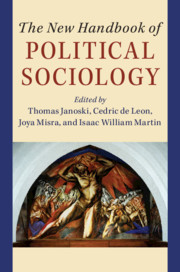Book contents
- The New Handbook of Political Sociology
- The New Handbook of Political Sociology
- Copyright page
- Dedication
- Contents
- Tables
- Figures
- Contributors
- Acknowledgments
- Introduction
- I Theories of Political Sociology
- II Media Explosion, Knowledge as Power, and Demographic Reversals
- 10 “Old” Media, “New” Media, Hybrid Media, and the Changing Character of Political Participation
- 11 The Sociology of Official Information Gathering
- 12 The Dark and Light Sides of Big Data
- 13 States, Parties, and Expertise
- 14 Toward a Political Sociology of Demography
- III The State and Its Political Organizations
- IV Civil Society: The Roots and Processes of Political Action
- V Established and New State Policies and Innovations
- VI Globalization and New and Bigger Sources of Power and Resistance
- Index
- References
12 - The Dark and Light Sides of Big Data
How Big Data Is Transforming Political Sociology
from II - Media Explosion, Knowledge as Power, and Demographic Reversals
Published online by Cambridge University Press: 22 February 2020
- The New Handbook of Political Sociology
- The New Handbook of Political Sociology
- Copyright page
- Dedication
- Contents
- Tables
- Figures
- Contributors
- Acknowledgments
- Introduction
- I Theories of Political Sociology
- II Media Explosion, Knowledge as Power, and Demographic Reversals
- 10 “Old” Media, “New” Media, Hybrid Media, and the Changing Character of Political Participation
- 11 The Sociology of Official Information Gathering
- 12 The Dark and Light Sides of Big Data
- 13 States, Parties, and Expertise
- 14 Toward a Political Sociology of Demography
- III The State and Its Political Organizations
- IV Civil Society: The Roots and Processes of Political Action
- V Established and New State Policies and Innovations
- VI Globalization and New and Bigger Sources of Power and Resistance
- Index
- References
Summary
The growth of Big Data has become central to the politics of contemporary societies and stimulated new research in political sociology. Citizens and states increasingly depend on the Internet, cell phones, social media, and other new information communication technologies (or ICTs) to communicate about politics and to mobilize, control, monitor, and influence politics (Castells 2009, 2012; Castells and Cardoso 2015). One of the most important consequences has been the “Twitter revolution” of using websites, blogs, social media, and cell phones to mobilize and coordinate political action. ICTs have lowered communication costs, provided platforms for forming new political identities and identifying grievances, devising strategies, organizing protests and collective action, creating citizen access to information (including internet hacks), carrying out administrative planning, and providing new platforms for democratic discussion and governance (the “light side”).
Keywords
- Type
- Chapter
- Information
- The New Handbook of Political Sociology , pp. 321 - 352Publisher: Cambridge University PressPrint publication year: 2020
References
- 1
- Cited by

